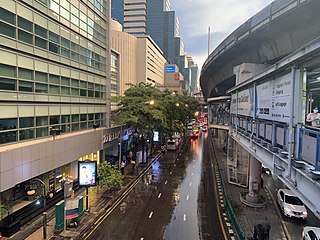
Si Lom Road is a major street in the Thai capital Bangkok, best known for its commercial neighbourhood, which, along with the nearby and roughly parallel Sathon Road, forms one of the city's main business districts. It runs in a southwest–northeast direction between Charoen Krung and Rama IV roads in the city's Bang Rak District, forming the boundary between Suriyawong Subdistrict to its north and Si Lom Subdistrict to its south. Si Lom was one of the earliest modern roads to be built in the city, and some of its side streets serve historic ethnic neighbourhoods from the late nineteenth century, while others are known as shopping and nightlife venues.

Bang Rak is one of the fifty districts (khet) of Bangkok, Thailand. It lies on the eastern bank of the Chao Phraya River, beyond Khlong Phadung Krung Kasem, which marked the old city boundary. Originating from riverside settlements dating from before the city's foundation, Bang Rak grew inland as new roads and canals were constructed through the area during the second half of the nineteenth century and the early twentieth, attracting communities of expatriates and developing into a major commercial district.
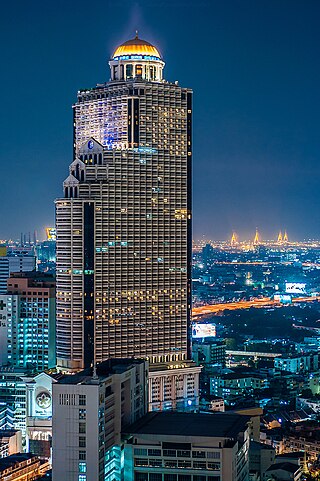
State Tower is a skyscraper located on Silom Road, Bang Rak business district, Bangkok, Thailand, adjacent to Charoen Krung Road. Built in 2001, it has a floor area of 300,000 m2 (3,200,000 sq ft). State Tower has 68 floors and is 247 m (810 ft) tall, making it the 8th tallest building in Thailand. It is also the tallest mixed-use building in Thailand.

The Elevated Train in Commemoration of HM the King's 6th Cycle Birthday 2nd line, also known as Silom Line, is one of the rapid transit lines of the BTS Skytrain System in Bangkok, Thailand.The line runs eastward from National Stadium Station in Pathum Wan District over Rama I Road and interchanges with the Sukhumvit Line at Siam station, then turns southward, following Ratchadamri, Si Lom, Naradhiwas Rajanagarindra and Sathon Roads to Taksin Bridge where it crosses the Chao Phraya River to the Thonburi side of Bangkok and Wong Wian Yai. It continues west along the Ratchapruek Road before it terminates at Bang Wa Station in Phasi Charoen District.
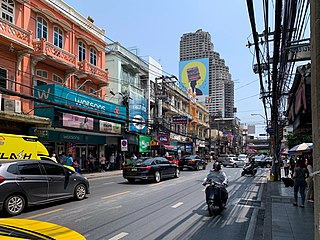
Charoen Krung Road is a major road in Bangkok and the first in Thailand to be built using modern construction methods. Built during 1862–1864 in the reign of King Mongkut, it runs from the old city centre in Rattanakosin Island, passes through Bangkok's Chinatown, continues into Bang Rak district, where it formerly served the community of European expatriates, and ends in Bang Kho Laem. Construction of the road marked a major change in Bangkok's urban development, with the major mode of transport shifting from water to land. Charoen Krung Road was Bangkok's main street up to the early 20th century, but later declined in prominence. It is still home to many historic buildings and neighbourhoods, which are beset by changes as extension of the underground MRT is poised to drive new development.
2012 Regional League Division 2 Bangkok Metropolitan Region is the 4th season of the League competition since its establishment in 2009. It is in the third tier of the Thai football league system.
2016 Regional League Division 2 Western Region is the 4th season of the League competition since its establishment in 2013. It is in the third tier of the Thai football league system.

Captain Bush Lane, now officially known as Soi Charoen Krung 30, is a side-street branching off Charoen Krung Road in Bang Rak District of Bangkok, Thailand. It was home to several members of Bangkok's early European expatriate community during the turn of the 19th–20th centuries, including Captain John Bush, an influential English sea captain after whom the street is named.

Si Phraya Road is a road in Bang Rak District, Bangkok, Thailand. It divides the areas of Maha Phruettharam and Si Phraya subdistricts. Built in 1906 by four noblemen of the rank phraya, the road runs from Si Phraya Pier at the mouth of the Phadung Krung Kasem Canal to Sam Yan Intersection, where it meets the Phaya Thai and Rama IV Roads.

Assumption College Samutprakarn is a private Catholic school in Samut Prakan Province, Thailand. The school was founded and run by the Brothers of St. Gabriel since 1979 as the thirteenth educational institution of the congregation. The school provides education to students from grade 1 through 12.
Assumption Suksa School (AS) is the first school affiliated with the Roman Catholic Archdiocese of Bangkok. It is a private school for girls located in Bangkok, Thailand. Assumption Suksa School was founded by Pastor Leo Perudong. This school provides general education for students from kindergarten 1 to grade 12 including kindergarten, primary school, secondary school, and high school education.

Surawong Road is a road in the Bang Rak District of Bangkok, Thailand, linking Charoen Krung Road to Rama IV and forming the boundary between Suriyawong and Si Lom subdistricts. It was built at the end of the 19th century during Bangkok's period of expansion following the country's opening up to the West, and was home to many leading businesses, upper-class families, and members of the expatriate community. It was known as a Western-style nightlife entertainment district during the 1920s, and was—and still is—home to many leading hotels. The road grew as a business district along with the nearby Si Lom Road during the mid-20th century, but lagged behind in development toward the end of the century due to its limited traffic capacity. Today, it is still home to several historic landmarks, as well as many well-known restaurants.

Chan Road, also known as Trok Chan, is a road and neighbourhood in Bangkok. It's a separate from Nang Linchi road in the area of Thung Maha Mek sub-district, Sathon district and runs through Chan - Naradhiwas intersection where it cuts across Naradhiwas Rajanagarindra road. In this phase, it also acts as a line between Sathon district's Thung Wat Don and Yan Nawa district's Chong Nonsi sub-district, then through two more intersections were Tai Duan Chan junction and Sathu - Chan junction as far as end at Trok Chan junction, where it combined with Charoen Krung road in the area of Wat Phraya Krai sub-district, Bang Kho Laem district, total distance is 7.0 km. At the end of the road on Charoen Krung side is close to two historic sites are Asiatique The Riverfront, originally, it was the location of the Danish maritime navigation company East Asiatic Company and Protestant Cemetery, include another place of education is Shrewsbury International School.
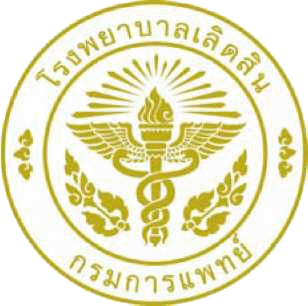
Lerdsin Hospital is a hospital located in Bang Rak District, Bangkok, Thailand. It is a main teaching hospital for the College of Medicine, Rangsit University. It is an affiliated teaching hospital of the Faculty of Medicine Siriraj Hospital, Mahidol University and the Faculty of Medicine, Srinakharinwirot University.

The East Asiatic Building is a historic building in Bangkok's Bang Rak District. It sits on the eastern bank of the Chao Phraya River, opposite the Oriental Hotel on Soi Charoen Krung 40 and adjacent to the Catholic Mission and Assumption Cathedral. The building was built c. 1900 in Renaissance Revival style to designs by Annibale Rigotti, and served as the headquarters of the East Asiatic Company (Thailand) until 1995, receiving the ASA Architectural Conservation Award in 1984. In 2023, Asset World Corporation announced plans to renovate the building into a hotel under the Plaza Athénée brand, in partnership with Nobu Hospitality.
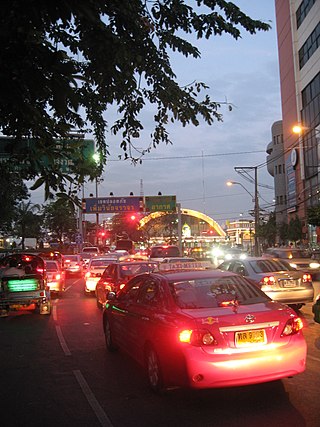
Maha Phruettharam is one of the five khwaeng (subdistrict) of Bang Rak District, Bangkok.

The Bangkok tram system (รถรางกรุงเทพ) was a transport system in Bangkok, Thailand. Its first-generation tram network first operated as a horse tram system, and was eventually converted to electric trams in the late nineteenth century.
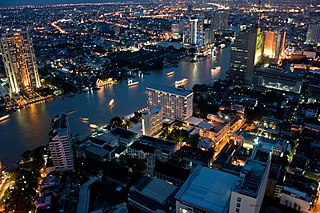
Bang Rak is a khwaeng (subdistrict) and historic neighbourhood in Bangkok's Bang Rak District. It lies between the Chao Phraya River and Charoen Krung Road, and was home to communities of European expatriates who settled in the area mostly during the second half of the 19th century as Siam opened up to the West. Among them were the Portuguese, French and British, whose embassies occupied extensive grounds in the area, Danes who founded shipping companies as well as the historic Oriental Hotel, and Catholic missionaries who established some of the first schools in the country on the grounds surrounding Assumption Cathedral.
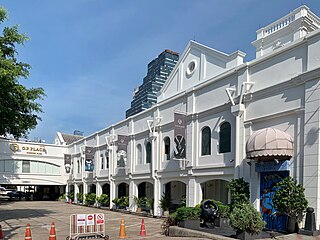
O.P. Place is a shopping centre housed in a historic building in the Bang Rak neighbourhood of the Thai capital Bangkok. The building was built in 1908 as the premises of Falck & Beidek, and was known to locals as Hang Sing Toh. It later became the Oriental Plaza, before its acquisition by the current owners. Today, its merchandise is focused on upscale antiques and collectibles, and the neoclassical building is recognized for its heritage architecture, having received the ASA Architectural Conservation Award in 1982.

The Embassy of France in Bangkok is the chief diplomatic mission of France in Thailand, and one of the oldest in the country. It was established as a consulate in its current location on the Chao Phraya River off Charoen Krung Road in Bangkok's Bang Rak District in 1857, following the signing of the Treaty of Friendship and Commerce which re-established diplomatic relations between the two countries the previous year. The mission was elevated to a legation in 1892 and an embassy in 1949, and supports the ambassador in promoting political, economic and cultural ties between the two countries.
















